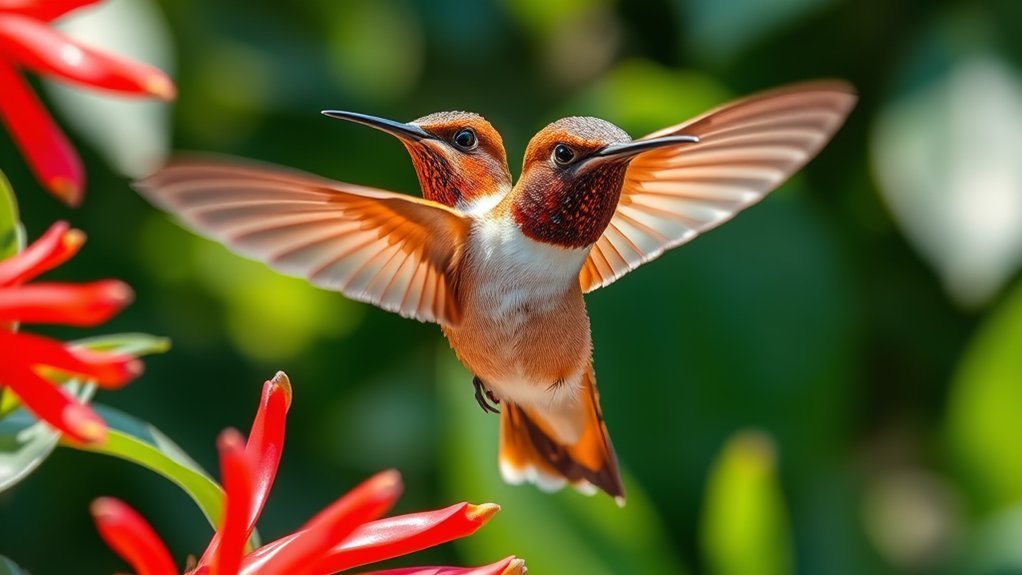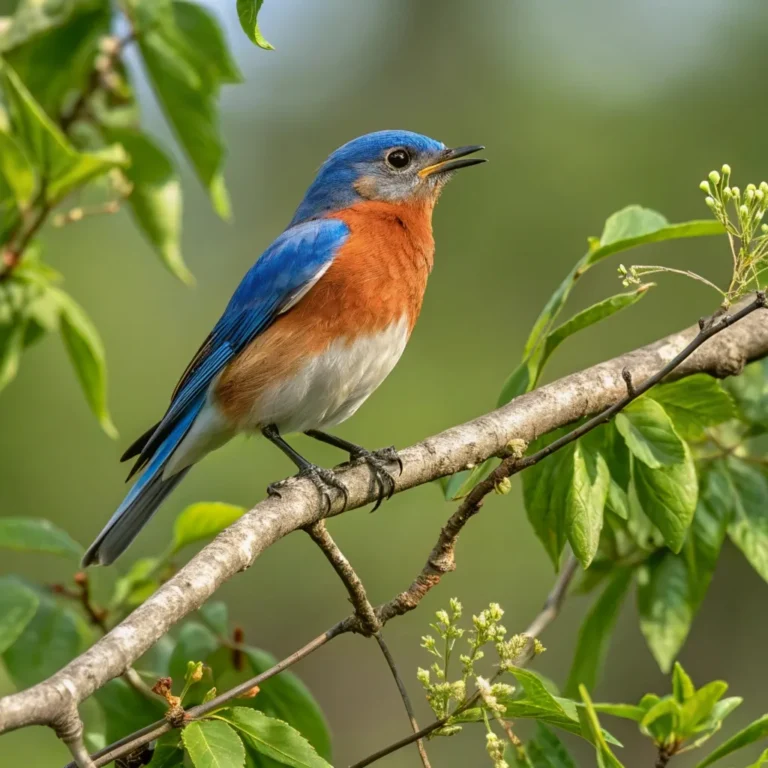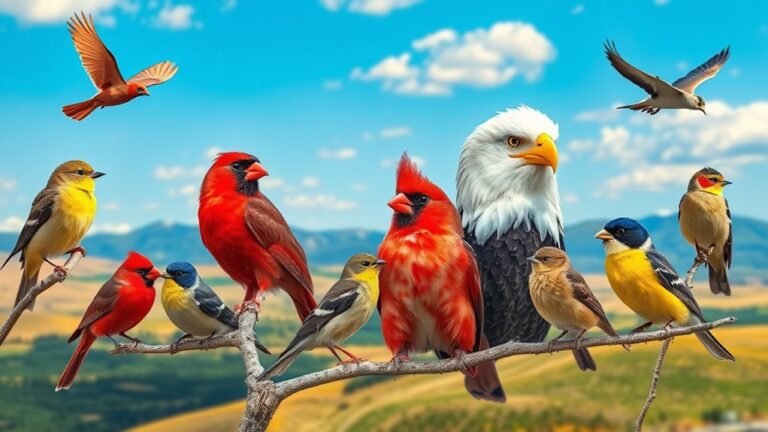Hummingbirds in Virginia: A Complete Species Guide
Hummingbirds in Virginia include several species, each with unique features. Key species are the Ruby-throated, Rufous, Calliope, and Black-chinned hummingbirds. Learning about their habitats and feeding habits can help you attract them to your garden. Their migration patterns reveal interesting behaviors that set them apart. Let's explore these fascinating birds in more detail.
Key Takeaways
Virginia is home to several species of hummingbirds, including the Ruby-throated, Black-chinned, Rufous, and Calliope hummingbirds. Each species has its own distinct characteristics.
The Ruby-throated Hummingbird is the most common in Virginia. This bird is known for its long migrations and plays a vital role in pollinating flowers.
Hummingbirds have unique tongues that allow them to feed on nectar efficiently. They are also known for their territorial behavior, which helps them guard their food sources.
The best times to view hummingbirds are in the early morning or late afternoon. Keep noise to a minimum and use binoculars for a better experience.
To support local hummingbird populations, create gardens with native flowers and maintain feeding stations. These actions contribute to their conservation.
The Hummingbird Species of Virginia

In Virginia, hummingbirds add vibrancy to gardens and yards. You can often see Ruby-throated, Black-chinned, and Calliope hummingbirds. Each species has unique feeding habits. Hummingbirds use their specialized tongues to gather nectar from tubular flowers effectively.
When it comes to nesting, these birds prefer hidden spots. They build nests using moss, spider silk, and plant down.
Female hummingbirds are responsible for making the nest and raising the young. They typically lay two eggs in each clutch.
By observing these behaviors, you can gain a greater appreciation for these amazing birds.
Engaging with the natural world enhances your experience and connection to Virginia's wildlife.
Ruby-throated Hummingbird
The Ruby-throated Hummingbird is a striking bird often found in gardens. It has bright plumage and impressive flying skills.
These birds undertake long migrations, traveling up to 500 miles non-stop across the Gulf of Mexico. This journey shows their strength and endurance.
When you watch them feed, you'll see their quick wing beats as they hover in front of flowers. They're skilled at extracting nectar, and in doing so, they help pollinate plants. This action is important for keeping ecosystems healthy.
Learning about the Ruby-throated Hummingbird helps you appreciate nature more. Their presence in Virginia adds beauty to the environment and strengthens our connection to the natural world.
Rufous Hummingbird

The Rufous Hummingbird has bright orange-red feathers and can be seen in Virginia during migration seasons. These birds travel long distances from their breeding areas in Alaska and the Pacific Northwest to winter in Mexico.
You may notice their fast flight and assertive feeding behavior, which are important for their survival. They like tubular flowers filled with nectar and actively defend their feeding areas from other birds.
To attract Rufous Hummingbirds, plant native flowers or set up hummingbird feeders with a sugar-water mix. Learning about their migration and feeding habits will help you appreciate the Rufous Hummingbird and connect with Virginia's bird life.
Calliope Hummingbird
While observing birdlife in Virginia, you may see the Calliope Hummingbird. This bird has a green back and a bright magenta throat. It's small, with a wingspan of about 4 inches and a body length of around 3 inches.
Calliope Hummingbirds migrate from the western United States to the southwestern regions and arrive in Virginia in late spring. They mainly eat nectar from various flowers and often defend their food sources aggressively.
During migration, you might notice their special flight patterns. Recognizing these traits helps you appreciate the role of this beautiful hummingbird in Virginia's ecosystem.
Black-chinned Hummingbird

If you're interested in observing different hummingbird species in Virginia, pay attention to the Black-chinned Hummingbird.
This bird has some notable traits, especially its behavior related to territorial displays and courtship.
Here are some features to help you identify them:
- Colorful feathers – Males have a distinctive black throat that stands out against their shiny green back.
- Sounds – Listen for sharp chirps that indicate their presence and mark their territory.
- Nesting habits – They often build nests in low shrubs or vines, making them easier to spot in gardens.
Though they're mostly found in the western U.S., Black-chinned Hummingbirds sometimes migrate to Virginia during the warmer months.
Keep an eye out for these unique visitors!
Migration Patterns of Hummingbirds
Understanding the migration patterns of hummingbirds is important for birdwatchers and conservationists. Each year, these small birds make incredible journeys. In spring, they travel north from their winter homes in search of warm weather and food. This migration usually begins in late February and can last until June, depending on the species and weather conditions.
In the fall, hummingbirds move south, typically from late August to October, to escape the cold weather. Observing these migration patterns helps birdwatchers plan their trips, allowing them to see hummingbirds at the best times.
Tracking their movements also supports conservation efforts, deepening our connection to these amazing birds during their seasonal changes.
Seasonal Behaviors and Activity
As the seasons shift, hummingbirds display different behaviors that match their changing environment. During breeding season, male hummingbirds perform impressive mating displays to attract females, showing off their colorful feathers and flying skills. Their activity changes throughout the year:
- Spring: Hummingbirds feed frequently on nectar-rich flowers to gain energy for mating.
- Summer: They establish and defend their feeding territories, often engaging in fierce competition with one another.
- Fall: As migration approaches, hummingbirds increase their feeding to build fat reserves for the journey.
By understanding these behaviors, you can create supportive environments that meet their needs.
Observing these incredible birds can enhance your appreciation for their resilience and adaptability across Virginia's landscapes. Enjoy watching them as they navigate the seasons!
Preferred Habitats of Hummingbirds
Hummingbirds thrive in a variety of habitats across Virginia. They prefer areas with plenty of nectar-producing plants. Common environments include gardens, meadows, and the edges of woodlands.
Hummingbirds need sunlight, moisture, and diverse flowers to support their feeding and nesting. These birds are attracted to flowering shrubs and trees, which offer food and shelter. Access to water sources is also important for their hydration.
Knowing where hummingbirds like to live helps us appreciate their behavior and understand their role in Virginia's ecosystem. Observing these vibrant birds enriches our connection with nature.
How to Attract Hummingbirds to Your Garden
To attract hummingbirds to your garden, create an environment suited to their needs. Start by choosing nectar-producing plants with bright flowers that will catch their attention.
Consider these options:
- Bee Balm – This plant has colorful blooms that draw many hummingbirds.
- Red Salvia – Its tall stalks offer a beautiful display and provide plenty of nectar.
- Cardinal Flower – The bright red flowers near water attract hummingbirds effectively.
Next, place feeders close to the blooming plants. This ensures a steady source of nectar.
Clean the feeders regularly and fill them with a sugar-water mix that resembles natural nectar.
Identifying Hummingbird Species
When you observe hummingbirds in your garden, it's important to recognize their species. Start by noting their size, color patterns, and any unique markings. For example, male Ruby-throated Hummingbirds show bright, iridescent throats, while females have more subdued colors.
Observe their feeding habits. Different species prefer different flowers and feeders.
Pay attention to how they move. Some species hover in place, while others dart quickly and perform aerial maneuvers.
Examine their bills. The length and shape of a bill can give clues about their feeding habits and favorite nectar sources.
Tips for Birdwatching Hummingbirds
How can you improve your birdwatching experience with hummingbirds? Here are some simple and clear tips to help you attract and observe them effectively:
- Set up feeding areas: Create a garden with bright flowers and place feeders filled with a 4:1 sugar-water mix. This will draw hummingbirds to your area.
- Time your visits: Visit during early mornings or late afternoons. Hummingbirds are most active during these times, making it easier to spot them.
- Be calm and patient: Stay still and keep quiet. Avoid sudden movements to increase your chances of seeing their amazing flying skills.
Conservation Efforts for Hummingbirds in Virginia
Hummingbirds are beautiful birds, but their populations in Virginia face threats. Habitat loss and climate change are significant concerns.
To help these birds, you can participate in conservation efforts that focus on preserving their habitat and involving the community.
One way to assist is to create or maintain gardens with native flowers. These gardens provide food for hummingbirds. You can also set up feeding stations with proper nectar recipes to support hummingbirds during migration.
Organizations like the Virginia Audubon Society lead programs that teach residents about these practices. By joining local conservation projects, you help hummingbirds thrive and meet others who care about protecting their habitats.
Every little action makes a difference.
Frequently Asked Questions
How Can I Differentiate Male and Female Hummingbirds in Virginia?
To differentiate male and female hummingbirds in Virginia, focus on their colors. Males usually have bright, shiny feathers. In contrast, females have more muted colors. You might also notice a size difference; males are often a bit smaller than females. Note these features to easily identify each gender.
What Are the Best Times to Observe Hummingbirds in Virginia?
To observe hummingbirds in Virginia, plan your visits during their spring and fall migration times. Early mornings and late afternoons are the best for viewing them. During these times, they are often more active and will be feeding, giving you a better chance to see these fascinating birds.
Are Hummingbirds Solitary or Do They Form Flocks?
Hummingbirds usually prefer to be alone. They often feed and mate by themselves. However, you can see them interacting socially at food sources or during mating. Knowing this behavior helps you appreciate their unique traits and interactions in nature.
Can I Keep a Hummingbird as a Pet?
You cannot keep a hummingbird as a pet. Hummingbirds need specific habitats to thrive. They have unique social needs and require conditions that captivity cannot provide. It is best for these birds to live freely in the wild.
What Predators Threaten Hummingbirds in Virginia?
Hummingbirds in Virginia face threats from several predators. Hawks and domestic cats are two main dangers. These predators can reduce hummingbird populations significantly. Protecting their habitats is essential for their survival. Taking steps to ensure safe environments can help maintain healthy hummingbird numbers.

Kashvi is a passionate bird enthusiast and nature lover who has been fascinated by the world of birds for years. With a keen eye for detail and a love for learning, Kashvi is dedicated to sharing her knowledge and insights with fellow bird enthusiasts on Avian Enthusiasts. Through her engaging and informative articles, Kashvi aims to inspire others to join her in exploring the fascinating world of birds and to promote a deeper appreciation for these incredible creatures.







